Uni-T UT325F Bedienungsanleitung
Uni-T
Thermometer
UT325F
Lies die bedienungsanleitung für Uni-T UT325F (9 Seiten) kostenlos online; sie gehört zur Kategorie Thermometer. Dieses Handbuch wurde von 51 Personen als hilfreich bewertet und erhielt im Schnitt 4.8 Sterne aus 26 Bewertungen. Hast du eine Frage zu Uni-T UT325F oder möchtest du andere Nutzer dieses Produkts befragen? Stelle eine Frage
Seite 1/9

P/N:110401111884X
UT325F
4-Channel Thermometer
User Manual

1 2
Introduction
Structure
Thermocouple channel T1, T2, T3, T4 input
USB interface
Display screen
Buttons
Tripod nut
Battery cover
Figure 1
LCD Indicators/Icons
The LCD indicators/icons are shown in Figure 2.
1. Settings
2. Bluetooth communication
3. USB communication
4. Data record
5. Timing measurement mode
6. Auto power off
7. Battery status
8. Primary display of four-channel value
9. Temperature units
10. Time
11. Delete the saved data
12. Offset value compensation
13. Recording interval
14. Thermocouple type
15. Temperature difference between channels
16. Data hold
Short press
Difference between channels/Return
Start/Stop recording the data
Turn on/off the backlight
Data hold/Confirm the setting
Enter the timing measurement
mode/Up or add the value
Unit switching/Down or
subtract the value
Long press
Enter/Exit the setting interface
/
Power on/off
/
Exit the timing measurement mode/
Turn on or off the Bluetooth
/
Button
EN
Figure 2
UT325F
4-Channel Thermometer User Manual
Overview
UT325F 4-Channel Thermometer ("Thermometer") is a high- accuracy digital thermometer that uses a
thermocouple as the temperature probe and comes with a microprocessor.
Features:
It can work with type K, J, T, E, R, S and N thermocouples.
With four-channel temperature measurement, the temperature difference can be displayed.
It can set the time interval to automatically record data.
72,000 groups of data can be stored.
Offset value compensation can be set.
It can connect to a smartphone (Android or iOS) via Bluetooth and edit or view the recorded data and
save and export charts in the smartphone APP.
It can connect to a computer via the USB cable to edit or view the recorded data and save and export
charts in the PC software.
Use the thermometer according to the steps in this user manual. Otherwise, the protection provided by
the product may be impaired.
Safety Instructions
Warning
A Warning identifies conditions and actions that pose hazards to users. To avoid electric shock or personal
injury, please follow these instructions.
Check the housing for broken or missing plastic parts, especially insulation around joints before using
the thermometer. Do not use the thermometer if it is damaged.
Disconnect the thermocouple from the thermometer before opening the housing.
When is displayed on the screen, replace the batteries as soon as possible.
If the thermometer is not operating properly, do not continue to use it because the protection provided
by the product may have been impaired. If in doubt, the thermometer should be sent to a designated
place for repair.
Do not use the thermometer near explosive gases, vapors or dust.
Do not apply voltage between thermocouples or between the thermocouple and the ground terminal.
When potential difference between thermocouples may occur, an insulating thermocouple should be used.
Use the specified replacement parts when repairing the thermometer.
Do not use the thermometer with its housing or cover open.
Cautions
A Caution identifies conditions and procedures that could cause thermometer damage or equipment
under test damage. Please use the thermometer carefully.
Select the appropriate thermocouple, function scale or range scale when using the thermometer.
When taking multi-channel measurement, it is necessary to ensure that there is no potential difference
between the two channels.
Please do not try to charge the batteries.
Pay attention to the battery polarity when installing.
Setting Interface
In the main interface, long press to enter the setting interface. The symbol will show at the top left
of the screen. Press or to step through the setting options. The sequence is: Interval of auto
recording Saved data and deletion → Thermocouple type → Offset value compensation → Auto →
power off→ Power frequency anti-interference → Time → Restore factory settings.
Long press to exit the setting interface.
Interface Description
Interval of auto recording (INTERVAL)
Short press in this interface, and the second of the time in the lower right corner will blink. Press
or to add or subtract the blinking value. Press to set the value of hour, minute and second in
sequence. After setting, short press to save and return to the INTERVAL interface (If there is no
operation for a period of time, it automatically exits the modified state). Press to enter the next setting
interface.
Note: When the interval is 00: 00: 00, the auto recording function will be disabled and turn into manual
recording. Press to record the data once and stop recording.
Saved data and deletion (MEMORY)
In this interface, only the number of the saved data can be displayed. The information such as the recording
time and temperature can be viewed in the smartphone APP or PC software. Press to choose whether
to delete the saved data or not. The symbol “no” will flash by default. Press or to switch between
“yes” and “no”. When “yes” is flashing, press to turn into the “doing” interface (deleting). The data will
be deleted after one minute, and then it will return to the MEMOR Y interface (If there is no operation for
a period of time, it automatically exits the modified state). In the modified state, press to return. Press
to enter the next setting interface.
Note: When “doing” is displayed, it means that it takes a period of time to delete the historical data.
Thermocouple type (TYPE)
In this interface, short press , and the thermocouple type of the channel T1 will flash. At this time,
pressing or can switch the thermocouple type. Press to confirm the selection and to set the
thermocouple type of the channel T2. Repeat the preceding steps until the channel T4 is set up, and
press to save the settings and return to the TYPE interface (If there is no operation for a period of
time, it automatically exits the modified state). In the modified state, press to return. Press to enter
the next setting interface.
Offset value compensation (OFFSET)
In this interface, short press to display the temperature and the ambient temperature (E) of the channel
T1. The default compensation value “0.0” will flash. At this time, pressing or can adjust the
compensation value of the channel T1. Press to complete the T1 setting and enter the T2 setting.
Repeat the preceding steps until the channel T4 is set up, and press to save the settings and return
to the OFFSET interface (If there is no operation for a period of time, it automatically exits the modified
state). In the modified state, press to return. Press to enter the next setting interface.
1.1 Adjust the error of the temperature probe with the offset value
The reading of the thermometer can be adjusted and the error of a thermocouple can be compensated
in the OFFSET interface.
1. Insert the thermocouple into the input jack.
2. Place the thermocouple in a known and stable temperature environment such as an ice bath or dry
well calibrator.
3. Let the temperature readings settle down.
4. Change the offset compensation value according to the interface instructions until the temperature
reading is the same as the calibrated temperature.
Auto power off (SLP)
In this interface, short press to turn on/off the auto power off function. Press to enter the next setting
interface.
Power frequency anti-interference (Line)
In this interface, short press to switch between the power frequency anti- interference type 50Hz/60Hz.
Press to enter the next setting interface.
Time (Y M D h:m:s)
In this interface, short press to make the value of year/month/day/hour/ minute/second flash. Press
or to adjust the value. When the value of second is flashing, press , and “SAvE” will show on
the screen. Press again to confirm the adjustment, and “donE” will be displayed (If there is no operation
for a period of time, it automatically exits the modified state). Press to enter the next setting interface.
Restore factory settings (Sfr)
In this interface, short press to choose whether to restore factory settings or not. The symbol “no” will
flash by default. Press or to switch between “yes” and “no”. When “yes” is flashing, press to
restore factory settings and return to the main interface (If there is no operation for a period of time, it
automatically exits the modified state).
See the buttons detail as following
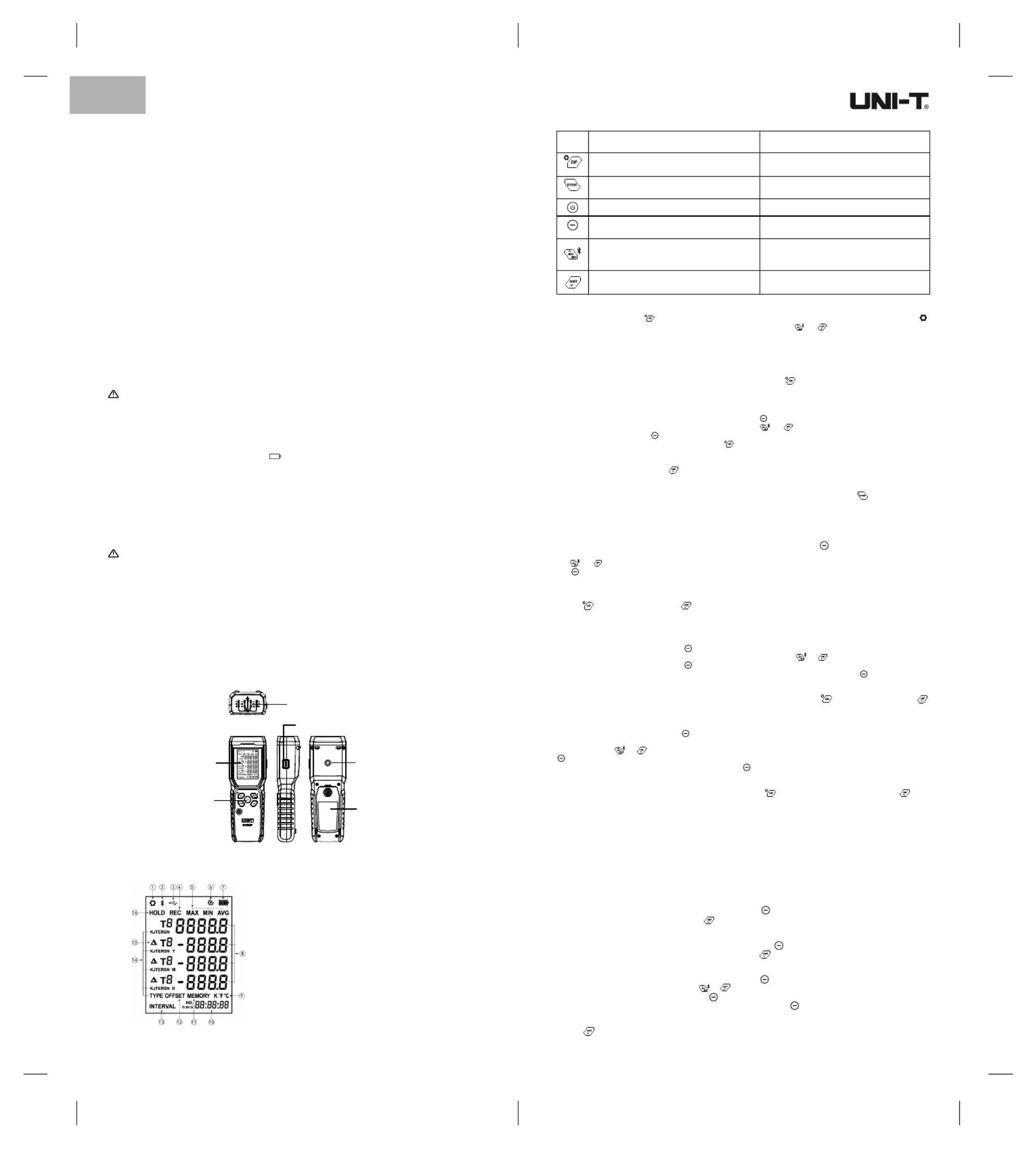
5 6
Appuyer brièvement
Valeur de différence entre les
canaux/retour lors de réglage
Démarrer/terminer
l'enregistrement des données
Allumer ou éteindre le rétro-éclairage
Maintien de la valeur/confirmation
du réglage
Entrer dans le mode de mesure par
chronométrage /réglage pour monter
ou augmenter la valeur.
Changement d'unité/réglage pour
descendre ou diminuer la valeur
Appuyer longuement
Entrer/sortir de l'interface de réglage
Non disponible
Marche/Arrêt
Non disponible
Quitter le mode de mesure par
chronométrage /activer ou
désactiver le Bluetooth.
Non disponible
UT325F
Thermomètre à Thermocouple à 4 Canaux
Manuel d’Utilisation
Connaître l’instrument
Pièces
Canaux de thermocouple
T1,T2,T3,T4 pour l'entrée
Ecran
Touches
Port USB
Ecrou de trépied
Couvercle de la pile
Ecran
Chaque caractère/segment de l'écran est illustré dans la figure 2.
figure 1.
figure 2.
1. Paramètres système
2. Bluetooth pour la communication
3. USB pour la communication
4. Enregistrement des données
5. Mode de mesure par chronométrage
6. Arrêt automatique
7. Indication de la charge de la pile
8. Affichage des valeurs de quatre canaux
9. Unité de température
10. Affichage du temps
11. Paramètres de stockage et d'effacement des données
12. Compensation de la valeur de déviation
13. Intervalle de temps d'enregistrement
14. Type de thermocouple
15. Différence de valeur entre les canaux
16. Maintien de la valeur
Touche
FR
Brève présentation de l'UT325F
Le thermomètre à thermocouple à 4 canaux UT325F (ci-après dénommé "thermomètre") est un
thermomètre numérique de haute précision qui utilise un thermocouple comme sonde de température
et qui est doté d'un microprocesseur.
Caractéristiques :
• Il est applicable aux thermocouples de type K, de type J, de type T, de type E, de type R, de type S et
de type N.
• Il existe quatre canaux pour la mesure de la température. Il peut afficher la différence de
température.
• Les utilisateurs peuvent définir des intervalles de temps pour enregistrer automatiquement les données.
• Il peut stocker 72 000 groupes de données.
• La compensation de la valeur de déviation peut être réglée.
• A l’aide du Bluetooth, il peut se connecter aux applications Android et IOS pour fonctionner. Les
utilisateurs peuvent consulter les données enregistrées, sauvegarder et exporter des graphiques.
• A l’aide de USB, il peut se connecter au logiciel sur PC pour fonctionner, et les utilisateurs peuvent
consulter les données enregistrées, sauvegarder et exporter des graphiques.
Veuillez utiliser le thermomètre conformément aux marches spécifiées dans ce manuel, sinon les pièces
de protection de l'instrument thermométrique risquent d'être endommagées.
Consignes de sécurité
Avertissement
Cette section indique une situation ou une action qui peut présenter un danger pour les utilisateurs.
Pour éviter les chocs électriques ou les blessures, veuillez suivre le guide suivant.
• Examinez le boîtier avant d'utiliser le thermomètre. Vérifiez que si le boîter est cassé ou si les pièces
en plastique sont perdues, en particulier l'isolation autour du joint. N'utilisez pas le thermomètre si son
extérieur est endommagé ;
• Avant d'ouvrir le boîter, déconnectez le thermocouple du thermomètre ;
• Lorsque le symbole d'indication de la pile " "apparaît, remplacez la pile dès que possible ;
• Si le thermomètre ne fonctionne pas correctement, ne continuez pas à l'utiliser. Les pièces de protection
peuvent avoir été endommagées. En cas de doute, envoyez le thermomètre au point désigné pour la
réparation.
• Ne jamais utiliser le thermomètre à proximité de gaz explosifs, de vapeur ou de poussière ;
• Ne jamais appliquer de tension électrique entre les thermocouples ou entre les thermocouples et la terre ;
• Lorsqu'il peut y avoir une différence de potentiel entre les thermocouples, il convient d'utiliser des
thermocouples isolants ;
• Lors de la réparation du thermomètre, il faut utiliser les pièces de rechange prévues à cet effet ;
• Lorsque le boîtier ou le couvercle du thermomètre est ouvert, ne pas utiliser le thermomètre.
Attention
Le contenu suivant énumère les situations ou les actions susceptibles d'endommager les instruments
ou les équipements testés. V euillez utiliser le thermomètre avec précaution pour éviter d'endommager
l’instrument ou l'équipement.
• Lors de l'utilisation du thermomètre, vous devez choisir un thermocouple, un échelon de fonction ou
d’échelle de mesure appropriés ;
• Lorsque plusieurs canaux sont utilisés pour la mesure, il faut s'assurer qu'il n'y a pas de dif férence de
potentiel entre deux canaux ;
• N'essayez jamais de charger la pile ;
• Lors de l'installation de la pile, vous devez distinguer les électrodes "+" et "-" de la pile.
Interface de réglage
Appuyez longuement sur sur l'interface principale pour accéder à l'interface de réglage, et le symbole
s'affiche en haut à gauche de l'écran. Appuyez sur les touches et , vous pouvez effectuer les
réglages suivants en avançant et en reculant. La séquence de cycle des réglages est la suivante: Réglage
de l'intervalle d'enregistrement automatique Informations sur le stockage des données et ef facement →
des données → Réglage du type de thermocouple → Réglage de la compensation de la valeur de déviation
→ Réglage de l'arrêt automatique → Réglage de l'antiparasitage de la fréquence de réseau → Réglage
du temps → Restauration des paramètres d'usine.
Une fois le réglage terminé, appuyez longuement sur la touche pour quitter l'interface de réglage.
Description des interfaces
• Réglage de l'intervalle d'enregistrement automatique
Dans cette interface, appuyez brièvement sur la touche , et les secondes dans le coin inférieur droit
clignotent. Sous l'état clignotant, appuyez sur les touches et pour augmenter ou diminuer la valeur,
et appuyez sur la touche pour régler les valeurs des minutes et des secondes. Une fois le réglage
terminé, appuyez brièvement sur la touche pour enregistrer les modifications, quitter l'état de
modification et revenir à l'interface de réglage de l'intervalle de temps (En état de modification, si
l'utilisateur n'effectue aucune opération, on quittera automatiquement l'interface au bout d'un certain
temps). Appuyez sur la touche pour accéder à l'interface de réglage suivante.
Note : Lorsque l'intervalle de temps est réglé à 00:00:00, la fonction d'enregistrement automatique
expire et l'appareil passe en mode d'enregistrement manuel. Appuyez sur la touche pour enregistrer
les données une fois et terminer l'enregistrement.
• Informations sur le stockage des données et effacement des données
Cette interface affiche uniquement la quantité de données enregistrées, et les informations telles que
le temps et la température enregistrés peuvent être consultés à l'aide d'une application mobile ou d'un
logiciel PC. Dans cette interface, appuyez brièvement sur la touche pour effacer les données
enregistrées. Lorsque le symbole "no" clignote, cela indique qu'aucun effacement n'est effectué. Appuyez
sur ou pour choisir si on ef face les données ou non. Lorsque le symbole "yes" clignote, appuyez
sur , l'interface "doing" s'affiche (l'effacement est en cours). Au bout d'une minute environ, les données
sont formatées et l'appareil passe automatiquement à l'interface de la quantité de stockage des données
(En état de modification, si l'utilisateur n'effectue aucune opération, on quittera automatiquement l'interface
au bout d'un certain temps). En état de modification, vous pouvez également revenir en appuyant sur la
touche . Appuyez sur la touche , pour accéder à l'interface de réglage suivante.
Note: Lors de l'effacement des données, seul le message "doing" s'af fiche à l'écran, ce qui signifie que
l'effacement des données historiques prendra un certain temps.
• Réglage du type de thermocouple
Appuyez brièvement sur la touche dans cette interface, et le caractère du type de thermocouple du
canal T1 clignote. Lorsqu’il clignote, appuyez sur les touches et pour commuter le type de
thermocouple. Appuyez sur la touche pour confirmer la sélection et entrer dans le réglage du thermocouple
du canal T2. L'opération est la même que ci-dessus jusqu'au canal T4. Appuyez sur pour enregistrer
le réglage et revenir à l'interface de réglage du type de thermocouple (En état de modification, si l'utilisateur
n'effectue aucune opération, on quittera automatiquement l'interface au bout d'un certain temps). En état
de modification, vous pouvez également revenir en appuyant sur la touche . Appuyez sur la touche ,
pour accéder à l'interface de réglage suivante.
• Réglage de la compensation de la valeur de déviation
Appuyez brièvement sur la touche dans cette interface, la température et la température ambiante E
du canal T1 s'affichent, et la valeur de compensation par défaut "0.0" clignote. A ce moment, appuyez
sur les touches et pour ajuster la valeur de compensation du canal T1, et appuyez sur la touche
pour terminer le réglage du canal T1 et entrer dans le réglage du canal T2. L'opération est la même que
ci-dessus jusqu'au canal T4. Appuyez sur la touche , enregistrez le réglage et revenez à l'interface de
réglage de la compensation de la valeur de déviation ( En état de modification, si l'utilisateur n'ef fectue
aucune opération, on quittera automatiquement l'interface au bout d'un certain temps). En état de
modification, vous pouvez également appuyer sur la touche pour retour. Appuyez sur la touche pour
accéder à l'interface de réglage suivante.
1.1 Ajuster l'erreur de la sonde de température par le réglage de la compensation de la valeur de déviation
L'option de réglage de la compensation de la valeur de déviation permet d'ajuster le relevé du thermomètre
afin de compenser l'erreur du thermocouple.
1. Insérez le thermocouple dans la prise d'entrée.
2. Placez le thermocouple dans un environnement à température stable et connue (tel qu'un bain de glace
ou un calibrateur de température à puits sec).
3. Stabilisez le relevée de la température.
4. Modifiez la valeur de compensation de la déviation conformément aux instructions de l'interface jusqu'à
ce que le relevé de la température corresponde à la température étalonnée.
• Réglage de l'arrêt automatique (SLP)
Dans cette interface, appuyez brièvement sur la touche pour activer ou désactiver la mise en veille
automatique, puis appuyez sur la touche pour passer à l'interface de réglage suivante.
• Réglage de l'antiparasitage de la fréquence de réseau (Line)
Dans cette interface, appuyez brièvement sur la touche pour commuter l'antiparasitage de la
fréquence de réseau 50Hz/60Hz, et appuyez sur la touche pour accéder à l'interface de réglage suivante.
• Réglage du temps (A M J h:m:s)
Dans cette interface, appuyez brièvement sur la touche pour définir l'année, le mois, le jour , l'heure,
la minute et la seconde, et appuyez sur et pour ajuster des chiffres. Lorsque la seconde qui est la
dernière clignote, appuyez sur la touche , la signe "SAVE" clignote, vous devez confirmer si vous
voulez changer le temps. En appuyant à nouveau sur la touche , vous passez à l'interface "DONE",
ce qui indique que la modification est accomplie (En état de modification, si l'utilisateur n'effectue
aucune opération, on quittera automatiquement l'interface après un certain temps). Appuyez sur la
touche pour passer à l'interface de réglage suivante.
La description des touches est dans le tableau ci-dessous
Produktspezifikationen
| Marke: | Uni-T |
| Kategorie: | Thermometer |
| Modell: | UT325F |
Brauchst du Hilfe?
Wenn Sie Hilfe mit Uni-T UT325F benötigen, stellen Sie unten eine Frage und andere Benutzer werden Ihnen antworten
Bedienungsanleitung Thermometer Uni-T
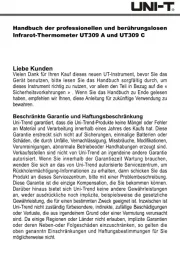
24 August 2025
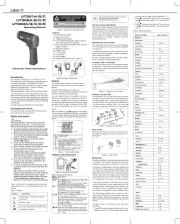
18 Juni 2025
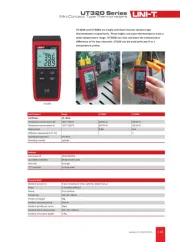
18 Juni 2025
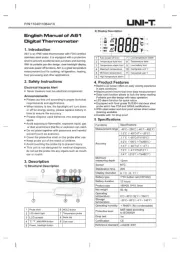
31 August 2024
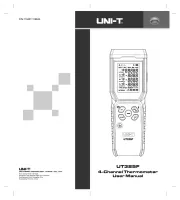
31 August 2024
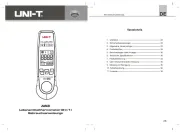
31 August 2024
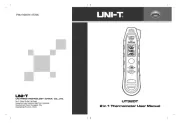
31 August 2024
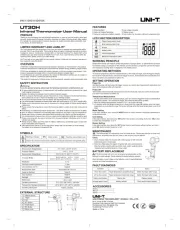
31 August 2024
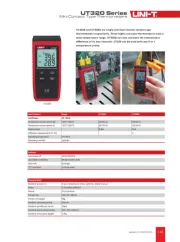
31 August 2024
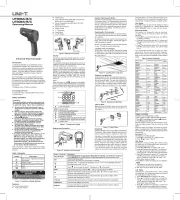
31 August 2024
Bedienungsanleitung Thermometer
- Comelec
- Gima
- Kyoritsu
- Clatronic
- Reer
- Bioland
- Welch Allyn
- Leifheit
- Guide
- AcuRite
- Blue Circle Medical
- PCE Instruments
- Oregon Scientific
- Laica
- Trotec
Neueste Bedienungsanleitung für -Kategorien-

24 August 2025
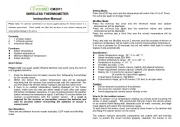
24 August 2025

23 August 2025
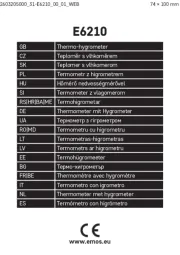
23 August 2025
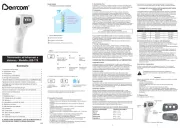
20 August 2025
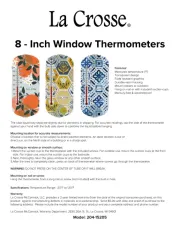
18 August 2025

18 August 2025
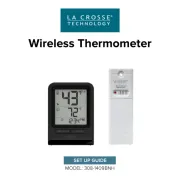
18 August 2025
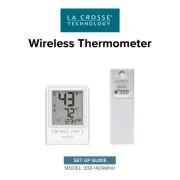
18 August 2025
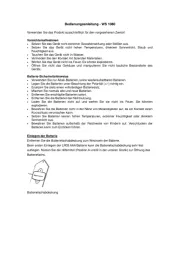
16 August 2025